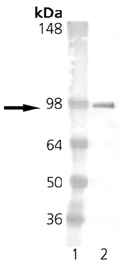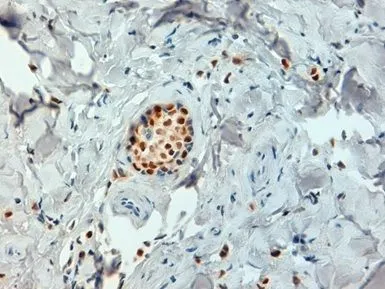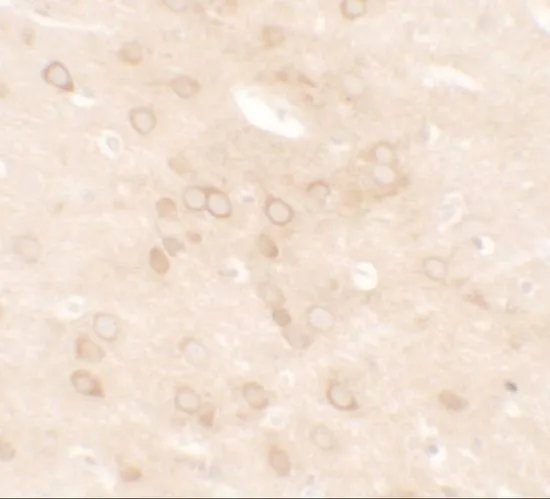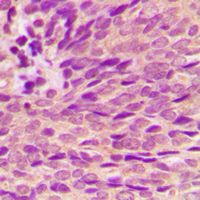
Western blot analysis of ESR1: Lane 1: MWM Lane 2: Estrogen Receptor 1 GST-tagged ER1 protein control runs at 92 kDa
Estrogen Receptor alpha antibody [h-151]
GTX13538
ApplicationsImmunoFluorescence, ImmunoPrecipitation, Western Blot, ImmunoCytoChemistry
Product group Antibodies
TargetESR1
Overview
- SupplierGeneTex
- Product NameEstrogen Receptor alpha antibody [h-151]
- Delivery Days Customer9
- Application Supplier NoteICC/IF: Use at an assay dependent dilution. IP: Use at a concentration of 15 microg/ml. WB: 1:250. Predicted molecular weight: 71.4 kDa. Optimal dilutions/concentrations should be determined by the end user.
- ApplicationsImmunoFluorescence, ImmunoPrecipitation, Western Blot, ImmunoCytoChemistry
- CertificationResearch Use Only
- ClonalityMonoclonal
- Clone IDh-151
- Concentration1 mg/ml
- ConjugateUnconjugated
- Gene ID2099
- Target nameESR1
- Target descriptionestrogen receptor 1
- Target synonymsER, ESR, ESRA, ESTRR, Era, NR3A1, estrogen receptor, E2 receptor alpha, ER-alpha, estradiol receptor, estrogen nuclear receptor alpha, estrogen receptor alpha E1-E2-1-2, estrogen receptor alpha E1-N2-E2-1-2, nuclear receptor subfamily 3 group A member 1, oestrogen receptor alpha
- HostMouse
- IsotypeIgG1
- Protein IDP03372
- Protein NameEstrogen receptor
- Scientific DescriptionThis gene encodes an estrogen receptor, a ligand-activated transcription factor composed of several domains important for hormone binding, DNA binding, and activation of transcription. The protein localizes to the nucleus where it may form a homodimer or a heterodimer with estrogen receptor 2. Estrogen and its receptors are essential for sexual development and reproductive function, but also play a role in other tissues such as bone. Estrogen receptors are also involved in pathological processes including breast cancer, endometrial cancer, and osteoporosis. Alternative promoter usage and alternative splicing result in dozens of transcript variants, but the full-length nature of many of these variants has not been determined. [provided by RefSeq, Mar 2014]
- Storage Instruction-20°C or -80°C,2°C to 8°C
- UNSPSC12352203


![IHC-P analysis of human breast carcinoma tissue using GTX17904 Estrogen Receptor alpha antibody [ESR1/1935].](https://www.genetex.com/upload/website/prouct_img/normal/GTX17904/GTX17904_20200115_IHC-P_355_w_23060620_163.webp)
![WB analysis of full-length human ER alpha recombinant protein and ER beta protein using GTX22746 Estrogen Receptor alpha antibody [33] at 4 microg/ml (left panel) or GTX25786 Estrogen Receptor beta antibody at 1:2000 (right panel).](https://www.genetex.com/upload/website/prouct_img/normal/GTX22746/GTX22746_1582_WB_w_23060620_315.webp)




![ChIP analysis of sheared chromatin from MCF7 cells treated for 1 hour with estradiol using GTX60340 Estrogen Receptor alpha antibody [GT9004]. The IPd DNA was analysed with an Illumina Genome Analyzer. Library preparation, cluster generation and sequencing were performed according to the manufacturers instructions. The 36 bp tags were aligned to the human genome using the ELAND algorithm. This figure shows the obtained peaks near the TFF1 gene on chromosome 21 (figure 1A), the GREB1 and HAAO genes on chromosome 2 (figure 1B and C), and the ZNF185 gene on the X-chromosome (figure 1D).](https://www.genetex.com/upload/website/prouct_img/normal/GTX60340/GTX60340_20201117_ChIP_64_w_23061123_131.webp)